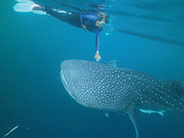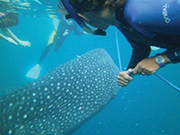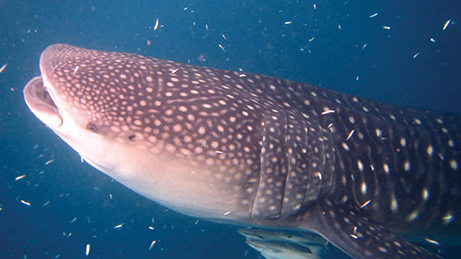Rebecca and Patrick Childress, who are world cruising aboard their Valiant 40 Brick House, celebrated Rebecca’s birthday by spending the dawn swimming with whale sharks in eastern Indonesia. Here is her report as excerpted from her blog at whereisbrickhouse.com (published April 2015)
From the safety of our dinghy, we were a leaf on the surface as the fish with the greatest length and bulk we had ever seen glided in the greenish water three meters below. Even if they are called “gentle giants” it did not seem wise to risk ticking one off. Their 300 rows of teeth are less penetrating than 200 grit sand paper but the force behind the bite would easily turn an arm or leg to chum.
But we had no worries about becoming Jonahs, the whale shark will only swallow very small fish and plankton. With mask and flippers snuggly in place, we slipped into the nutrient rich water. This would be our third swim with a whale shark. The shark was feeding on a cloud of dead minnows but coughed up a trout size fish. We had paid fishermen on a netting boat to throw their catch back into the water to keep the whale shark circling for an hour.


It took quick leg strokes of our flippers to get out of the path of the circling behemoth. At times, a snorkeler had to retract his legs and turn into a human ball floating at the surface to let the whale shark pass below, untouched. On one circuit, which developed too quickly for my reaction, like a broad shouldered high schooler pushing his intimidation, I was the target for a certain head on collision with the giant shark. The only thing I could try was to place my flat palmed hand on the top of the fish’s snout. The slight pressing down was enough to gently guide the amazingly agile fish to descend and slide on past leaving me only the dorsal fin to dodge. But then there was the swaying tail approaching like a huge fly swatter. To be swished with a fish’s aircraft size tail is a humbling water-park like experience.
This all started in an area off the west coast of New Guinea in an area called Triton Bay. We awoke before sunup and divided up the nine crew from 3 long distance cruising yachts into two dinghies. We had to be at the stationary fish netting boat, called a “bagan”, just before sunup when they lift their nets for the last time of the night. The whale sharks are there to pick up the spilled scraps. But the more generous the spilled fish the more likely the whale sharks will linger before moving on to another bagan.















